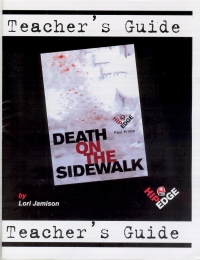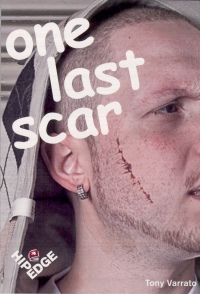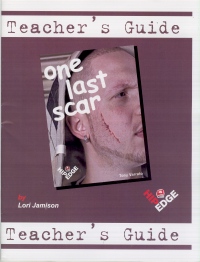| ________________
CM . . .
. Volume XVII Number 9. . . .October 29, 2010 
 |
Death on the Sidewalk. (HIP Edge).
Paul Kropp.
Toronto, ON: HIP Books, 2010.
110 pp., pbk., $12.95.
ISBN 978-1-897039-42-7.
Grades 7-11 / Ages 12-16.
Review by Karen Boyd.
** /4 |
| |
|

 |
Death on the Sidewalk Teacher’s Guide.
Lori Jamison.
Toronto, ON: HIP Books, 2010.
19 pp., stapled, $7.95.
ISBN 978-1-897039-96-0.
Grades 7-11 / Ages 12-16.
Review by Karen Boyd.
** /4 |
| |
|

 |
One Last Scar. (HIP Edge).
Tony Varrato.
Toronto, ON: HIP Books, 2010.
103 pp., pbk., $12.95.
ISBN 978-1-897039-43-4.
Grades 7-11 / Ages 12-16.
Review by Karen Boyd.
** /4 |
| |
|

 |
One Last Scar Teacher’s Guide.
Lori Jamison.
Toronto, ON: HIP Books, 2010.
19 pp., stapled, $7.95.
ISBN 978-1-897039-97-7.
Grades 7-11 / Ages 12-16.
Review by Karen Boyd.
** /4 |
| |
|

excerpt:
Fifteen-year-old Allie Carson was going shopping. As she put on her ski jacket and gloves, she thought about getting some new boots. She thought about the crowds in the stores.
She thought about this guy she liked at school.
She thought about a dozen things, but she never thought about getting shot. She never thought her life would end with a flash from a gun. A bullet. A spray of blood from her neck.
But it did. (From Death on the Sidewalk.)
“Ethan,” Jarrett said overstating my name again. “Get the car ready.”
“It’s running.
It’s running!” I told him. Then I looked down at the old lady taped to a chair. “Let me call an ambulance before we go.”
Jarrett pulled a pistol out of his jacket and fired twice into the woman’s chest.
“No phone call needed.” Then he turned the gun on me. “Now get in the car!” (From One Last Scar.)
Death on the Sidewalk, written by Paul Kropp, is based on the true story of the 2005 Boxing Day killing of Jane Kreba in Toronto. The book documents the colliding paths of Allie, JR, and Curtis. JR, a decent kid with a questionable peer group, has his IPod stolen by Curtis, a wannabe drug dealer and gangster. JR’s friends take revenge by beating up Curtis, an act which leads to Curtis’ group seeking revenge. The stakes are higher as the weapons move from fists to knives and finally to guns and Allie is caught in the crossfire. The book ends by showing the destruction of lives in a variety of ways from the single incident.
Tony Varrato portrays Ethan as a “honourable” thug who follows a code of conduct and set of rules in One Last Scar. For example, “Rule number 2: Don’t hurt nobody who doesn’t ask for it,” suggests that Ethan is essentially a good person. Ethan gets caught up in a home invasion/drug deal that goes wrong, and he breaks many of his rules. Ethan deals with loyalty and betrayal while trying to put things right. Technology plays a central role in the plot of this story, as texting is the main mode of communication between the characters. It is also texting that reveals betrayal and a cell phone call that leads police to the evidence.
The ”Hip Edge” books are specifically designed for “the reluctant or striving reader.” They are based on current issues and include characters that “talk just like real teens.” The readability is tightly controlled, and illustrations throughout the text support readers. With their photographic covers and catchy titles, the books are designed to appeal to teen readers. Clearly written and fast paced, both novels are easy reads with smooth transitions and up-front information. As with many of these controlled vocabulary texts for adolescent readers, the characteristics that make them accessible to a variety of readers also make for a fairly simplistic, contrived story. Death on a Sidewalk relies heavily on foreshadowing, almost to a point of being comical, as Allie’s day is broken into a series of everyday events with the final event counted down as each chapter ends. One Last Scar wraps up neatly and quickly, but many questions remain about the motivation of many of the characters. There is an underlying assumption in the books that reluctant readers have trouble not only decoding, but also understanding complex ideas. I think this is problematic.
The teacher’s guides provide some good instructional ideas, chapter synopsis and after reading activities. Death on the Sidewalk’s guide provides background information to the true story on which it is based, while the guide to One Last Scar focuses on personal “rules” or values that people live by. Both pre-reading activities provide opportunities for discussion and developing prior knowledge to support reading. While before reading and after reading are supported in the guides, there is no mention of during reading strategies that could support readers in the actual process. The after reading is focused on more heavily, while a focus on before reading may be of greater support to striving readers. Often, it is these types of follow-up questions and activities that further turn striving readers away from reading which may negate much of the good work that the novel does to encourage and support engagement with the text.
While both books accomplish what they state they will do in the teacher’s guides, the approach makes me a little uncomfortable. There is certainly a place for books that provide success to reluctant readers, but all reluctant readers are not alike, and many are resistant to reading, not because of the text, but because of the approach to studying text which is promoted in the teacher’s guides. As a choice to recommend as an independent read and a place to start discussion and response, or possibly as a book club choice, Death on the Sidewalk and One Last Scar work very well. Teacher’s may want to forego the teacher’s guides.
Recommended with reservations.
Suzanne Pierson is a retired teacher-librarian, currently instructing librarianship courses at Queen’s University in Kingston, ON.
 To comment
on this title or this review, send mail to cm@umanitoba.ca.
To comment
on this title or this review, send mail to cm@umanitoba.ca.
Copyright © the Manitoba Library Association. Reproduction for personal
use is permitted only if this copyright notice is maintained. Any
other reproduction is prohibited without permission.
NEXT REVIEW |
TABLE OF CONTENTS FOR THIS ISSUE
- October 29, 2010.
AUTHORS |
TITLES |
MEDIA REVIEWS |
PROFILES |
BACK ISSUES |
SEARCH |
CMARCHIVE |
HOME |
|



